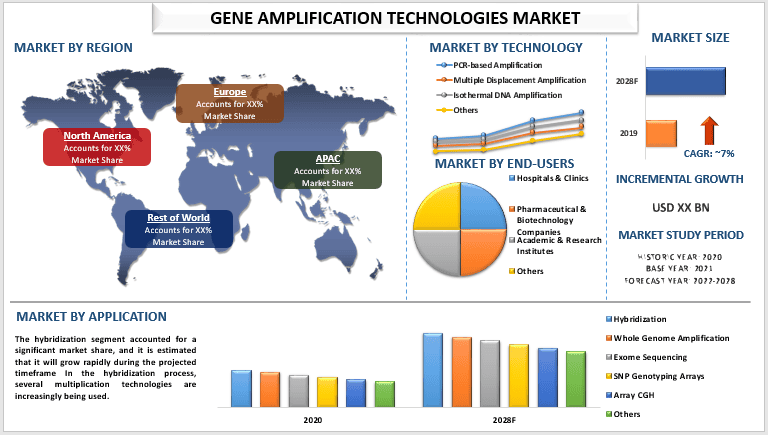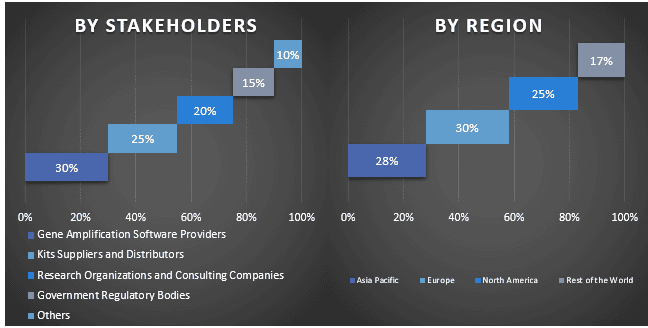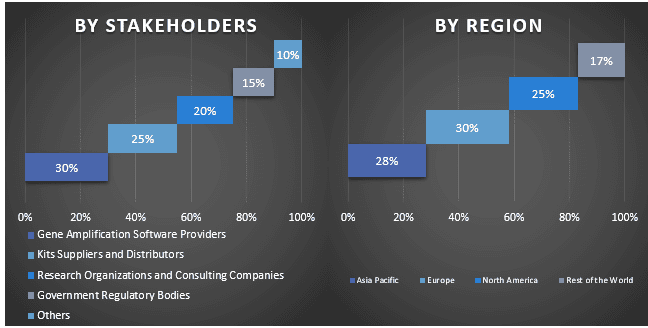Emphasis on Technology (PCR-based Amplification, Multiple Displacement Amplification, Isothermal DNA Amplification, Others); Application (Whole Genome Amplification, Exome Sequencing, SNP Genotyping Arrays, Array CGH, Hybridization, Others); End-User (Hospitals & Clinics, Pharmaceutical & Biotechnology Companies, Academic & Research Institutes, Others); and Region/Country

The gene amplification technologies market is expected to register a CAGR of approx. 7% over the period of 2022-2028. Gene amplification technology is a critical component of genomics that is widely used in diagnostics. For various studies, it assists in increasing the number of copies of a gene. Gene amplification is frequently carried out using dendritic polymers, transcription-mediated amplification, polymerase chain reaction to ligase chain reaction, and other methods. The main purpose of gene amplification technology is to compare the gene of the study sample with the genes of other germline or somatic cells. The growing demand for gene amplification technologies can be attributed to the expanding need for research and development in the fields of genetic testing, molecular diagnostics, and genomics which boosts the adoption of organic growth strategies among key industry players around the globe. For instance, in august 2022, QIAGEN launched new solutions that significantly accelerate DNA variant detection and RNA sequencing of low-input samples. QIAseq Targeted DNA Pro Panels are based on improved chemistry that halves to six hours the time researchers need for library preparation of DNA samples. Owing to the glaring statistics the increasing development of numerous diagnostic tests based on various gene amplification methods led to the growing demand for gene amplification technologies and would contribute to the growth of the market in the forthcoming period as well. In addition, the introduction of novel and advanced products and the growing acceptance of personalized medicine are likely to aid the market growth. Furthermore, the gene amplification technologies market is anticipated to grow on account of government regulations, decreasing sequencing costs together boosting the research field. However, some of the restraints in the market including the high costs of these technologies and limited awareness about genome sequencing are impeding the growth of this market all over the world.
Qiagen NV; New England Biolabs; Illumina, Inc.; Bio-Rad Laboratories, Inc.; BGI Genomics Co Ltd; Oxford Nanopore Technologies PLC; PerkinElmer, Inc.; Becton Dickinson and Co; Bayer AG; and Agilent Technologies Inc are some of the key players in the market. Several M&As along with partnerships have been undertaken by these players to facilitate customers with hi-tech and innovative products/technologies.
Insights Presented in the Report
“Amongst technology, the PCR-based amplification category accounted for the significant share in the market in 2020”
Based on the technology, the gene amplification technologies market is segmented into PCR-based amplification, multiple displacement amplification, isothermal DNA amplification, and others. The PCR-based amplification segment accounted for a significant market share, and it is estimated that it will grow rapidly during the projected timeframe. PCR technology is widely used in a variety of end-use applications. Furthermore, the widespread use of PCR for COVID-19 detection has resulted in significant revenue generation by this technology.
“Amongst application, the hybridization category is expected to witness considerable CAGR during the forecast period”
Based on the application, the market is fragmented into whole genome amplification, exome sequencing, SNP genotyping arrays, array CGH, hybridization, and others. The hybridization segment grabbed a considerable market share, and it is expected to grow at a significant CAGR during the forecast period. In the hybridization process, several multiplication technologies are increasingly being used.
“Amongst end-users, the pharmaceutical & biotechnology companies’ category is expected to witness considerable CAGR during the forecast period”
Based on the end-users, the market is fragmented into hospitals & clinics, pharmaceutical & biotechnology companies, academic & research institutes, and others. The pharmaceutical & biotechnology companies segment grabbed a considerable market share, and it is expected to grow at a significant CAGR during the forecast period. These businesses are concentrating on the creation of molecular diagnostic tests based on amplification techniques, which is promoting market expansion. Additionally, the market is expected to grow due to the expansion of applications in areas such as drug discovery, food quality control, bioremediation, and others.
“North America to witness significant growth during the forecast period”
For a better understanding of the market adoption of gene amplification technologies, the market is analyzed based on its worldwide presence in the countries such as North America (U.S., Canada, and Rest of North America), Europe (Germany, France, Italy, Spain, U.K., and Rest of Europe), Asia-Pacific (China, Japan, India, Australia, and Rest of APAC), and Rest of World. North America constitutes a major market for the gene amplification technologies industry owing to the presence of various genetic research programs in the region, as well as strong research and a commercial base for gene multiplication products and growing funding by numerous government organizations in medical research and its infrastructure, which are the major factors contributing to the growth of the market.
Reasons to buy this report:
Customization Options:
Global gene amplification technologies market can further be customized as per the requirement or any other market segment. Besides this, UMI understands that you may have your own business needs, hence feel free to connect with us to get a report that completely suits your requirements.
1. Market Introduction
2. Research Methodology Or Assumption
3. Market Synopsis
4. Executive Summary
5. Impact Of Covid-19 On The Gene Amplification Technologies Market
6. Global Gene Amplification Technologies Market Revenue, 2020-2028f
7. Market Insights By Technology
8. Market Insights By Application
9. Market Insights By End-users
10. Market Insights By Region
11. Gene Amplification Technologies Market Dynamics
12. Gene Amplification Technologies Market Opportunities
13. Gene Amplification Technologies Market Trends & Insights
14. Demand And Supply Side Analysis
15. Value Chain Analysis
16. Strategic Insights
17. Competitive Scenario
18. Company Profiled
19. Disclaimer
Research Methodology for the Global Gene Amplification Technologies Market Analysis (2022-2028)
Analyzing the historical market, estimation of the current market, and forecasting the future market of the global gene amplification technologies market were the three major steps undertaken to create and analyze the adoption of gene amplification technologies in major regions globally. Exhaustive secondary research was conducted to collect the historical market numbers and estimate the current market size. Secondly, to validate these insights, numerous findings and assumptions were taken into consideration. Moreover, exhaustive primary interviews were also conducted, with industry experts across the value chain of the global gene amplification technologies market. Post assumption and validation of market numbers through primary interviews, we employed a top-down/bottom-up approach to forecasting the complete market size. Thereafter, market breakdown and data triangulation methods were adopted to estimate and analyze the market size of segments and sub-segments the industry pertains to. Detailed methodology is explained below:
Analysis of Historical Market Size
Step 1: In-Depth Study of Secondary Sources:
Detail secondary study was conducted to obtain the historical market size of the gene amplification technologies market through company internal sources such as annual report & financial statements, performance presentations, press releases, etc., and external sources including journals, news & articles, government publications, competitor publications, sector reports, third-party database, and other credible publications.
Step 2: Market Segmentation:
After obtaining the historical market size of the gene amplification technologies market, we conducted a detailed secondary analysis to gather historical market insights and share for different segments & sub-segments for major regions. Major segments included in the report as the technology, application, and end-users. Further country-level analyses were conducted to evaluate the overall adoption of testing models in that region.
Step 3: Factor Analysis:
After acquiring the historical market size of different segments and sub-segments, we conducted a detailed factor analysis to estimate the current market size of the gene amplification technologies market. Further, we conducted factor analysis using dependent and independent variables such as an expanding need for research and development in the fields of genetic testing, molecular diagnostics, genomics, etc. globally. A thorough analysis was conducted for demand and supply-side scenarios considering top partnerships, mergers and acquisitions, business expansion, and product launches in the gene amplification technologies market sector across the globe.
Current Market Size Estimate & Forecast
Current Market Sizing: Based on actionable insights from the above 3 steps, we arrived at the current market size, key players in the global gene amplification technologies market, and market shares of the segments. All the required percentage shares split, and market breakdowns were determined using the above-mentioned secondary approach and were verified through primary interviews.
Estimation & Forecasting: For market estimation and forecast, weights were assigned to different factors including drivers & trends, restraints, and opportunities available for the stakeholders. After analyzing these factors, relevant forecasting techniques i.e., top-down/bottom-up approach was applied to arrive at the market forecast about 2028 for different segments and sub-segments across the major markets globally. The research methodology adopted to estimate the market size encompasses:
Market Size and Share Validation
Primary Research: In-depth interviews were conducted with the Key Opinion Leaders (KOLs) including Top Level Executives (CXO/VPs, Sales Head, Marketing Head, Operational Head, and Regional Head, Country Head, etc.) across major regions. Primary research findings were then summarized, and statistical analysis was performed to prove the stated hypothesis. Inputs from primary research were consolidated with secondary findings, hence turning information into actionable insights.
Split of Primary Participants in Different Regions

Market Engineering
Data triangulation technique was employed to complete the overall market estimation and to arrive at precise statistical numbers for each segment and sub-segment of the global gene amplification technologies market. Data was split into several segments & sub-segments post studying various parameters and trends in the areas of technology, application, and end-users in the global gene amplification technologies market.
The main objective of the Global Gene Amplification Technologies Market Study
The current & future market trends of the global gene amplification technologies market were pinpointed in the study. Investors can gain strategic insights to base their discretion for investments on the qualitative and quantitative analysis performed in the study. Current and future market trends determined the overall attractiveness of the market at a regional level, providing a platform for the industrial participant to exploit the untapped market to benefit from a first-mover advantage. Other quantitative goals of the studies include:

Customers who bought this item also bought